FourFourTwo's 50 Biggest Derbies in the World: 50-41
Welcome to FFT's countdown of football's biggest rivalries – and it all kicks off with chicken dances, secret police, consumer electronics and voodoo...

Words: Gary Parkinson, Chris Flanagan, Louis Massarella, Daniel Edwards, Rafael Luis Azevedo
#FFTderbies The 50 Biggest Derbies in the World: list and features here
50. Sheffield United vs Sheffield Wednesday
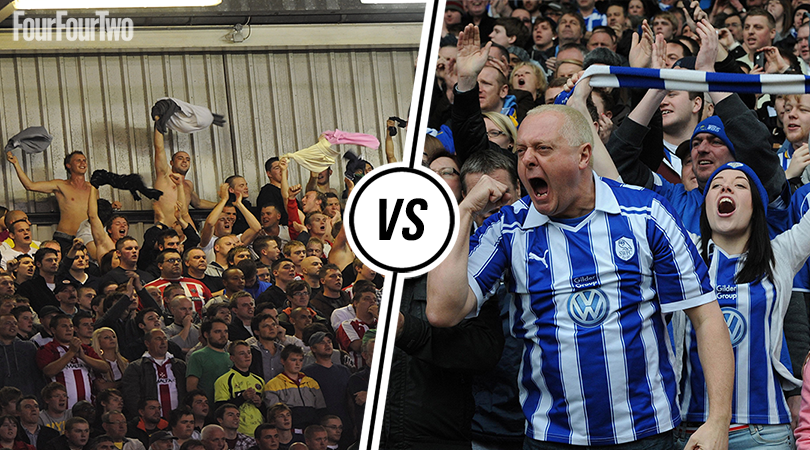
The first derby in Sheffield took place in 1860, when Sheffield FC’s patient three-year wait for opposition was ended by Hallam. But the true Steel City Derby started in 1890, and has since been one of football’s closest encounters: United have won 49, Wednesday 48 with 45 draws.
The highest-profile clash was the 1993 FA Cup Semi-Final, won 2-1 by Wednesday after extra-time at Wembley; only four of the 116 league derbies have been outside the top two divisions. Hostilities were renewed in 2017/18 after a five season wait which neither club much enjoyed. GP
READ THIS: More Than A Game: Sheffield United vs Sheffield Wednesday
49. Blooming vs Oriente Petrolero
The best features, fun and footballing quizzes, straight to your inbox every week.
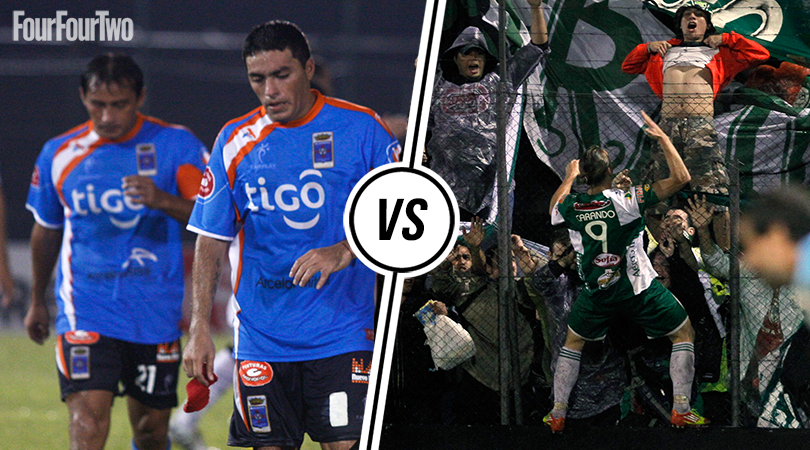
A scuffle led to a player directing a flying kung-fu kick to the face"
You can expect fireworks at the Clasico Cruceno in Bolivia’s biggest city, Santa Cruz. They may not be as successful as national powerhouses Bolivar and The Strongest (who are surely compensating for something), but Blooming are five-time champions, named somewhat poetically after flowering youth; rather more prosaically, four-time champions Oriente Petrolero were formed by oil workers. And they don’t half wind each other up.
In 2008, Oriente Petrolero’s Marcelo Aguirre celebrated a goal with a chicken dance, which sparked three red cards and a mass brawl; police had to step in before play could be restarted. This never happened to Kevin Nolan. Anyway, Blooming hit back a year later as a scuffle led to Sergio Jauregui directing a flying kung-fu kick to the face of Oriente’s Leonardo Medina. Both players were sent off, and Jauregui was banned for nine months. Oriente are ahead on victories, but Blooming claimed the biggest triumph, 5-0 in 1994 – even if the match didn’t actually finish: an Oriente pitch invasion caused the last 20 minutes to go unplayed. CF
48. Portland Timbers vs Seattle Sounders
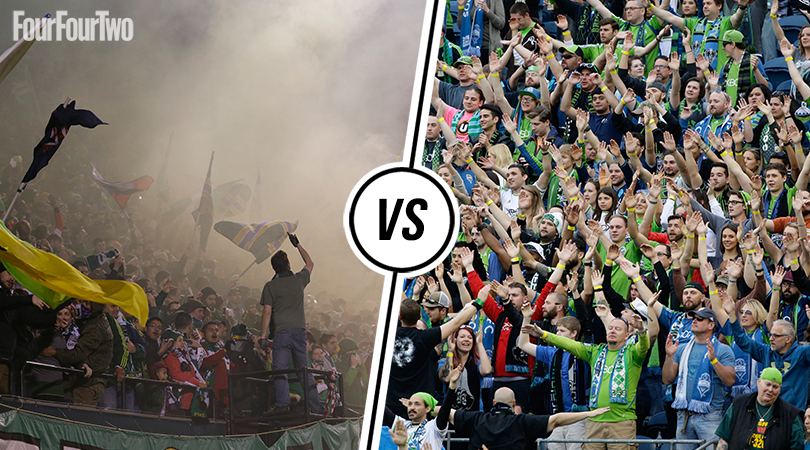
Although separated by 173 miles of Interstate 5, Portland and Seattle are virtually on each others’ doorsteps by North American standards: MLS Western Conference rivals Vancouver and Houston are 2,400 miles apart. Dating back to 1975, this Pacific Northwest spat has spanned four different leagues – from the now-defunct North American Soccer League, through the Western Soccer Alliance and United Soccer League, to become turbocharged since 2011, when the Timbers joined the Sounders in MLS.
It’s the league’s biggest grudge match (and usually its best-attended: the last four at Seattle’s stadium have all been in the top seven crowds in MLS history), and while violence is rare, the fans express their vociferous mutual dislike through songs and giant tifos. The rivalry has even extended up to local ‘dignitaries’, with Portland mayor Sam Adams and his entire staff forced to wear Sounders scarves for an entire day after losing a bet with his Seattle counterpart Mike McGinn over a game in 2011. LM
FFT's 100 Best Stadiums Portland's Providence Park • Seattle's CenturyLink Field
47. Lyon vs Saint-Etienne
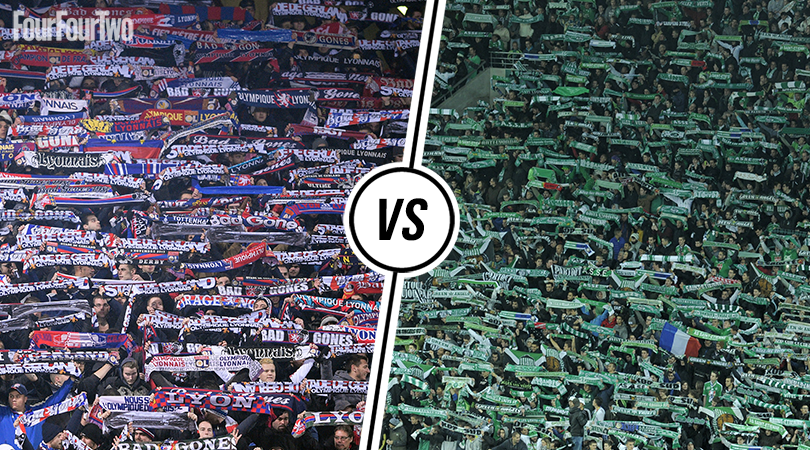
It's the blue-collar working class against the white-collar admin workers"
With little regard for the Academie Française’s desires to Anglicise the language, this Rhône-Alpes rivalry is known as Le Derby. Barely 30 miles apart, the teams first clashed in 1951, and came to represent the perceived nature of each city: Saint-Etienne as the blue-collar working-class opposite to Lyon’s white-collar admin workers.
The workers held the upper hand to start with, les Verts of Saint-Etienne scooping 10 league titles between 1957 and 1981 and reaching the 1976 European Cup Final, while enjoying a 7-1 win at their neighbours in 1969. But they sank into the doldrums and from 2002 Lyon rather reset the balance by winning a startling seven successive Ligue 1 titles. The two sides are now regularly contesting for top-six places, giving this bitter old battle fresh relevance and impetus. GP
READ THISMore Than A Game: Lyon vs Saint-Etienne
46. Newell’s Old Boys vs Rosario Central
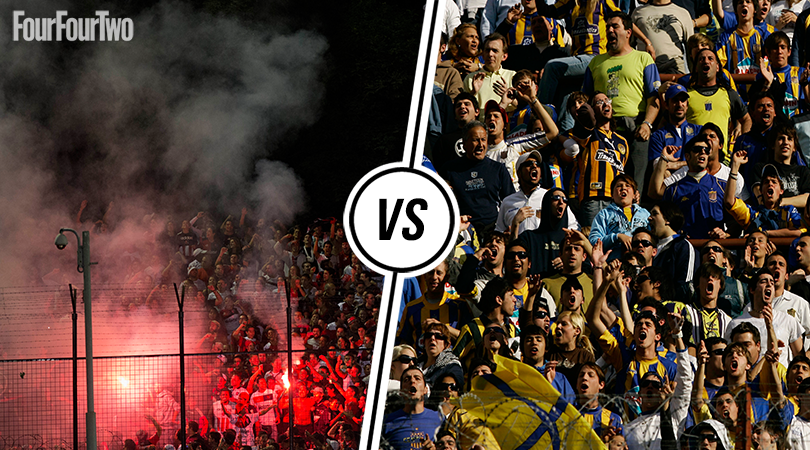
They could be veteran’s teams run by Mike Newell and Robert Rosario, but they’re not. Instead they’re veterans of the Argentine top division, based in the country’s third-biggest city Rosario, with famous fans: Lionel Messi represented Newell’s Old Boys before leaving for Barcelona at 14, while Che Guevara was a Rosario Central fan before joining the Cuban Revolution.
The rivalry intensified in the 1920s, when the city was hit by a leprosy epidemic; a local hospital asked the clubs to play a fund-raiser, but Rosario Central refused. Newell’s fans branded them ‘cads’ (well, it was the 1920s), so Rosario hit back by calling their rivals ‘the lepers’. The nickname stuck.
Former Espanyol, Atletico Madrid and Liverpool wideman Maxi Rodriguez is now back with his first club the Lepers, but things turned nasty in 2015 when rival Rosario fans peppered his grandmother’s house with bullets and daubed threatening messages on the walls. But relations have never been cordial. In 1974 Newell’s made a late comeback in the final match of the Metropolitano championship to beat Rosario to the title. A pitch invasion swiftly led to running battles and the match had to be suspended. DE
FFT's 100 Best Stadiums Rosario Central's Gigante di Arroyito
45. Athletic Bilbao vs Real Sociedad

The Basque derby – or Euskai Derbia, to the locals – is a curious thing. There are some schisms between those from the working-class port of Bilbao and the better-heeled resort of San Sebastian, while Athletic fans remain proud of their Basque-only selection policy, a principle abandoned by la Real in the late 1980s.
But much more so than most local disputes, this game has often been a unified show of solidarity against the common enemy – namely governance by Madrid. Under General Franco, regional identity was effectively criminalised; a fortnight after the dictator’s death, the two captains proudly waved the illegal Basque flag to an ecstatic derby crowd. GP
READ THIS More Than A Game: Athletic Bilbao vs Real Sociedad
FFT's 100 Best Stadiums Athletic's San Mames
44. Everton vs Santiago Wanderers
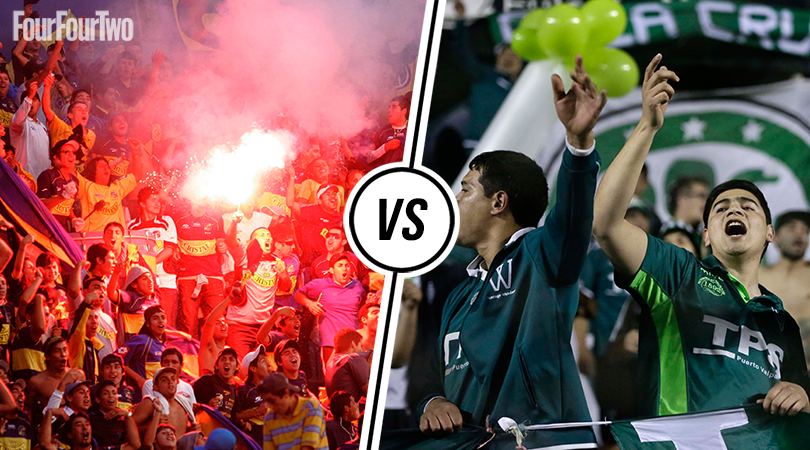
That’ll be Everton de Vina del Mar, four-time Chilean champions but slipped into the second tier in 2014 after being relegated alongside Rangers (no, not them either). Thrice-champions Santiago Wanderers aren’t from Santiago – they’re from the gritty port city of Valparaiso, and there was another team called Valparaiso Wanderers. Vina del Mar is a richer, more tourist-friendly city five miles up the coast; the rivalry is known as the Clasico Porteno – the Seaport Derby.
Everton fans like to recall a rather one-sided Copa Carlos Varela match in 1950, which they won 17-0 at their pleasingly named Estadio Sausalito. Santiago Wanderers refuse to acknowledge what they insist was a preparatory fixture featuring youth players, noting that they didn’t even start with 11. Thanks to dismissals and injuries, they had even fewer by the end: either six or seven, depending on which reports you believe.
It’s not the only derby to end short-sided: in 2013, Santiago triumphed 3-0 in a match that saw five players sent off, and a more recent meeting in the Copa Chile had to be suspended after fans rioted on the pitch before kick-off. CF
43. FC Seoul vs Suwon Bluewings

It’s indicative of Korea’s consumer-electronics clout that this is partly a clash between two of the world’s largest brands: LG and Samsung own FC Seoul and Bluewings respectively. But it’s a bit more complicated than that. Under the K League’s decentralisation policy, in 1996 the club then known as LG Cheetahs were relocated from Seoul to Anyang, a satellite city 12 miles south of the capital and a mere couple of miles from Bluewings’ Suwon home.
Eight years later, fans united in vain against LG forcing a move back to the capital’s vacant World Cup stadium, along with a name change to FC Seoul. Bluewings supporters were outraged and refused to acknowledge the new entity, but the success of the two clubs means that the ‘Super Match’ is now Korea’s key fixture. You might not see crowd trouble, but you may encounter amusing small-mindedness, such as the 2006 spat in which each club’s scoreboard listed the opposition player names in tiny writing. Which, while childishly funny, seems a waste of a good screen… GP
FFT's 100 Best Stadiums FC Seoul's Sangam Stadium
42. Bahia vs Vitoria
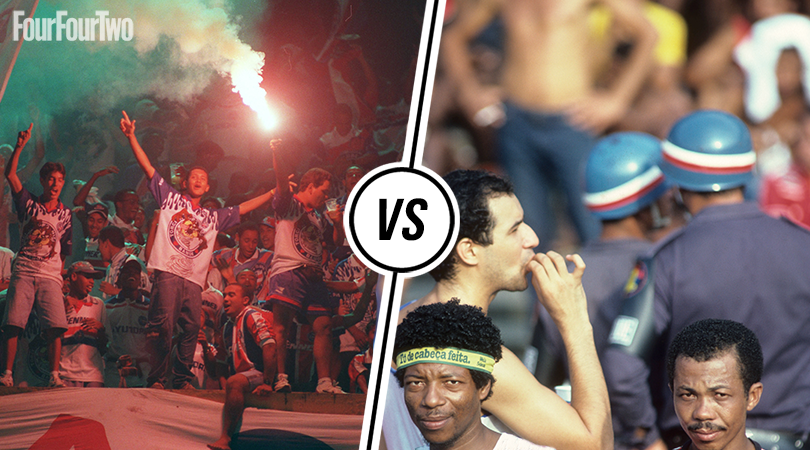
The Brazilian east-coast city of Salvador was a landing point for the slave trade; 80% of the population are of African descent, and the mixing of Catholic and African beliefs created macumba, a local version of voodoo. Early Bahia and Vitoria stars make offerings to African gods in an attempt to secure victory, although as coach Nenem Prancha pointed out: “If macumba had the power to win matches, it would be a draw.”
In a mid-’90s derby, Vitoria midfielder Preto chose a rather blunter approach, provoking Bahia’s Parreira by hinting that he had slept with his opponent’s wife. It worked: a retaliating Parreira was sent off and moaned to the media about what Preto had said. That only resulted in taunts from Vitoria fans when the sides met again, angering Parreira so much that he punched Preto and was sent off again. Still furious, Parreira broke into Preto’s apartment after the game, pointed a gun at his head and ordered him to promise that the alleged adultery had never happened.
Back in 1934, Bahia’s Bitonha assaulted the referee in a derby and was sent off, then arrested. He was so distraught to see his actions condemned in the newspapers that he committed suicide. On a lighter note, in 1999 the match never took place as both clubs thought they were at home. The title was shared and everyone looked at their shoes. RLA
41. Dynamo Moscow vs Spartak Moscow
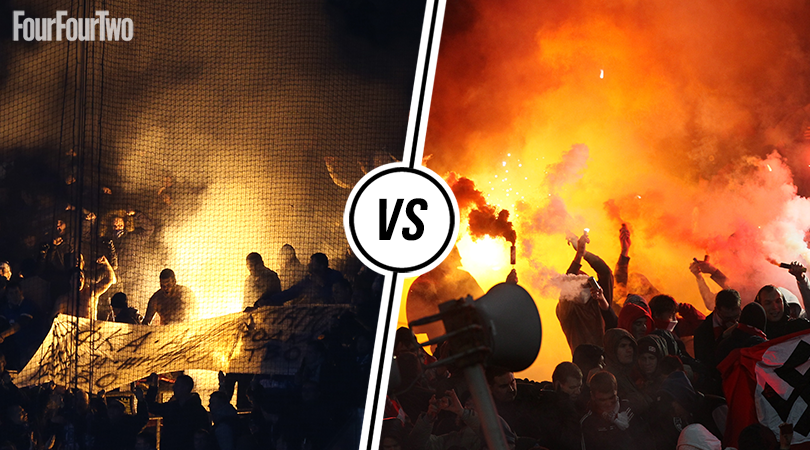
Moscow’s a big place – nearly 17 million people, several major clubs – but with all due respect to CSKA, Lokomotiv and Torpedo, the biggest and oldest derby is between Dynamo and Spartak. True, it rarely decides the silverware: Spartak only just won their first league title since 2001, while Dynamo haven't triumphed since 1976. But it’s the oldest remaining Muscovite derby – and there is, you may not be astonished to learn, a political side to it.
Formed by trade unionists in 1922, the club that became Spartak (whose nickname is ‘Meat’) quickly gained a rival in Dynamo, who reformed a year later. Spartak leaned heavily on the four brilliant Starostin brothers – who in 1942 were arrested on suspicion of an assassination plot against Joseph Stalin; it just so happened that secret police chief Lavrentiy Beria was a Dynamo patron. When Nikolai Starostin returned from the Siberian camps to become chairman of Spartak, he took particular personal interest in making sure the players were up for games against Dynamo. GP
FFT's 50 Biggest Derbies in the World: 50-41 • 40-31 • 30-21 • 20-11 • 10 • 9 • 8 • 7 • 6 • 5 • 4 • 3 • 2 • 1
#FFTderbies The 50 Biggest Derbies in the World: list and features here
Gary Parkinson is a freelance writer, editor, trainer, muso, singer, actor and coach. He spent 14 years at FourFourTwo as the Global Digital Editor and continues to regularly contribute to the magazine and website, including major features on Euro 96, Subbuteo, Robert Maxwell and the inside story of Liverpool's 1990 title win. He is also a Bolton Wanderers fan.
